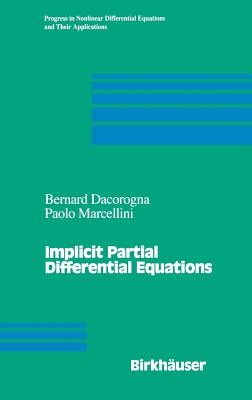
- We will send in 10–14 business days.
- Author: Bernard Dacorogna
- Publisher: Birkhäuser
- ISBN-10: 0817641211
- ISBN-13: 9780817641214
- Format: 16.4 x 24.2 x 1.9 cm, kieti viršeliai
- Language: English
- SAVE -10% with code: EXTRA
Reviews
Description
Nonlinear partial differential equations has become one of the main tools of mod- ern mathematical analysis; in spite of seemingly contradictory terminology, the subject of nonlinear differential equations finds its origins in the theory of linear differential equations, and a large part of functional analysis derived its inspiration from the study of linear pdes. In recent years, several mathematicians have investigated nonlinear equations, particularly those of the second order, both linear and nonlinear and either in divergence or nondivergence form. Quasilinear and fully nonlinear differential equations are relevant classes of such equations and have been widely examined in the mathematical literature. In this work we present a new family of differential equations called implicit partial differential equations, described in detail in the introduction (c.f. Chapter 1). It is a class of nonlinear equations that does not include the family of fully nonlinear elliptic pdes. We present a new functional analytic method based on the Baire category theorem for handling the existence of almost everywhere solutions of these implicit equations. The results have been obtained for the most part in recent years and have important applications to the calculus of variations, nonlin- ear elasticity, problems of phase transitions and optimal design; some results have not been published elsewhere.
EXTRA 10 % discount with code: EXTRA
The promotion ends in 23d.07:56:50
The discount code is valid when purchasing from 10 €. Discounts do not stack.
- Author: Bernard Dacorogna
- Publisher: Birkhäuser
- ISBN-10: 0817641211
- ISBN-13: 9780817641214
- Format: 16.4 x 24.2 x 1.9 cm, kieti viršeliai
- Language: English English
Nonlinear partial differential equations has become one of the main tools of mod- ern mathematical analysis; in spite of seemingly contradictory terminology, the subject of nonlinear differential equations finds its origins in the theory of linear differential equations, and a large part of functional analysis derived its inspiration from the study of linear pdes. In recent years, several mathematicians have investigated nonlinear equations, particularly those of the second order, both linear and nonlinear and either in divergence or nondivergence form. Quasilinear and fully nonlinear differential equations are relevant classes of such equations and have been widely examined in the mathematical literature. In this work we present a new family of differential equations called implicit partial differential equations, described in detail in the introduction (c.f. Chapter 1). It is a class of nonlinear equations that does not include the family of fully nonlinear elliptic pdes. We present a new functional analytic method based on the Baire category theorem for handling the existence of almost everywhere solutions of these implicit equations. The results have been obtained for the most part in recent years and have important applications to the calculus of variations, nonlin- ear elasticity, problems of phase transitions and optimal design; some results have not been published elsewhere.


Reviews